ASUS P8P67 Review
by Brendan van Varik on September 8, 2011 10:45 AM EST- Posted in
- Asus
- Motherboards
- P67
LAN Speed Test
LAN Speed Test is a freeware program designed for testing the network connection between two PCs on a home network. The speed of the transfer is limited by the lowest common denominator on the network, so if you have gigabit Ethernet capable computers but a 100 Mbit capable router, you are limit to 100 Mbit transfer. Note that this is really a formality – if a network port is rated at 1 Gbps, then chances are that it will hit at least 90+% of this value. The main test here is CPU usage, and how much is offloaded by the controller. For this test, we use LAN Speed Test to transfer a 1000 MB file across a home network with a 100 Mbps lowest common speed to the same machine each time, in a read/write scenario. CPU usage is taken as a visual max/average from task manager. Note: future LAN speed tests will be at the Gbps level.
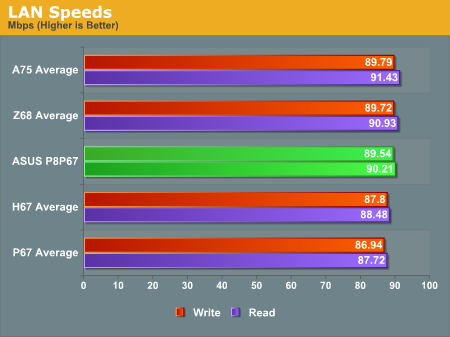
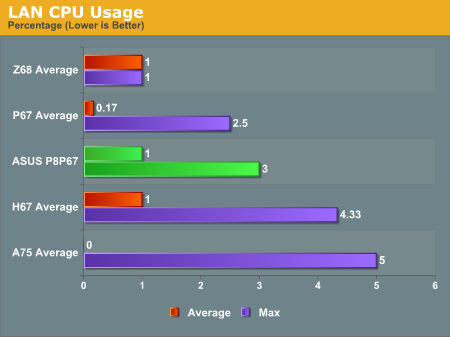
The results on this board are above average so that is a good sign. The CPU usage is low and that means the Realtek controller doing its job so that the transfer does not eat up too much of the systems resources.
DPC Latency
Deferred Procedure Call latency is a way in which Windows handles interrupt servicing. In order to wait for a processor to acknowledge the request, the system will queue all interrupt requests by priority. Critical interrupts will be handled as soon as possible, whereas lesser priority requests, such as audio, will be further down the line. So if the audio device requires data, it will have to wait until the request is processed before the buffer is filled. If the device drivers of higher priority components in a system are poorly implemented, this can cause delays in request scheduling and process time, resulting in an empty audio buffer – this leads to characteristic audible pauses, pops and clicks. Having a bigger buffer and correctly implemented system drivers obviously helps in this regard. The DPC latency checker measures how much time is processing DPCs from driver invocation – the lower the value will result in better audio transfer at smaller buffer sizes. Results are measured in microseconds and taken as the peak latency while cycling through a series of short HD videos - under 500 microseconds usually gets the green light, but the lower the better.
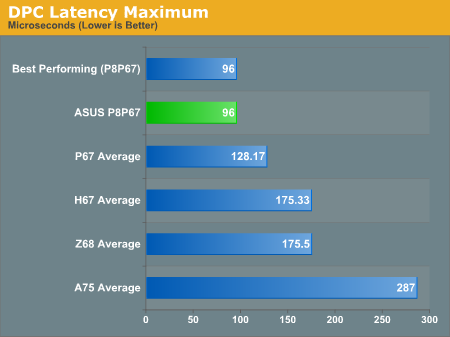
96us is the lowest latency we have had on the Sandy Bridge platform.
USB Speed
For this benchmark, we run CrystalDiskMark to determine the ideal sequential read and write speeds for the USB port using our 64GB Patriot SuperSpeed USB 3.0 drive. Then we transfer a set size of files from the SSD to the USB drive, and monitor the time taken to transfer. The files transferred are a 1.52 GB set of 2867 files across 320 folders – 95% of these files are small typical website files, and the rest (90% of the size) are the videos used in the Sorenson Squeeze test.
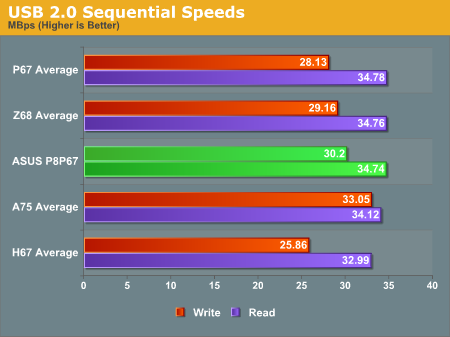
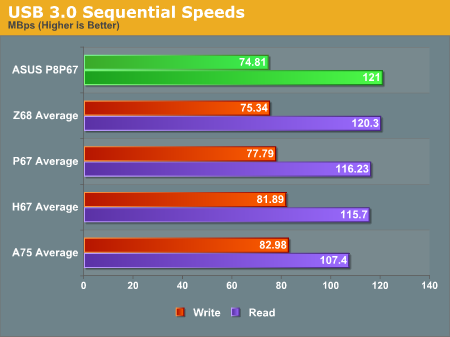

Overall, the P8P67 is only a fraction behind its bigger brother, the P8P67 Pro.
SATA Testing
We also use CrystalDiskMark for SATA port testing. The operating system is installed on the Micron RealSSD C300, which is rated at 355 MBps read and 215 MBps write, and the sequential test is run at the 5 x 1000 MB level. This test probes the efficiency of the data delivery system between the chipset and the drive, or in the case of additional SATA ports provided by a third party controller, the efficiency between the controller, the chipset and the drive.
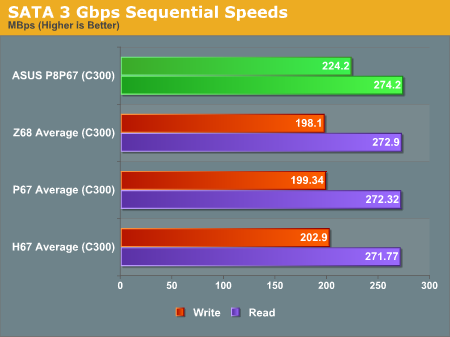

The P8P67 has given us the fastest set of SATA 3 Gbps write speeds we have seen thus far. Strangely enough, it is 25.2 MBps faster than the P8P67 Pro which costs more – however, the P8P67 Pro beats it in read speeds but only by 8 MBps.
Moving on to the SATA 6 Gbps results, the write speeds are good. Second from top is nothing to be sniffed at when you consider the price of the motherboard. The read speeds do not impress as much but they are not the slowest we have seen. It does beat the ASRock Extreme4 and the Gigabyte P67A-UD4 which are both in a similar price bracket but the Gigabyte board does have the upper hand when it comes to read speeds.










52 Comments
View All Comments
Blaster1618 - Thursday, September 8, 2011 - link
I am so tired of LGA-1155 being portrayed as an "Enthusiast Board"-Dual-channel memory.
-Narrow PCI Bus.
-Virtually fixed core clock.
-and the stake to the heart....on board graphics.
Wait...wait LGA-2011 and i7 3-series will spice up the M-board review business.
zero2dash - Thursday, September 8, 2011 - link
Troll much?Onboard graphics has no performance penalty on a 2600K (let alone a 2500K) so throw that piss poor reason out the window.
Narrow PCI bus? Yes, because that's clearly dragging SB systems through the mud. So is the dual channel memory.
Fixed core clock? Who gives a crap? Yeah, because a locked core clock with an unlocked multiplier is a worse option than an unlocked core clock and a limited amount of multiplier options.
Have fun paying for those quad channel ram kits.
A5 - Thursday, September 8, 2011 - link
A) Memory bandwidth has very little discernible effect on non-benchmark applications. Modern CPUs are so good at cache management that there is almost 0 reason to chase memory bandwidth. Ironically, the 1156 CPUs probably need the bandwidth more (due to the onboard graphics) than the 2011 CPUs will.B) If you need more than two PCI-e x8 slots, then you're the kind of person who will drop the cash on LGA-2011 anyway. This is a legit knock against P67 and Z68, but it also only affects the hardcore enthusiasts, the top 1% of the top 1% who are running 3 or 4 GPUs.
C) LGA-2011 is going to have fixed clocks too. With multipliers unlocked, this is kind of a moot point anyway.
D) Considering P67 doesn't even allow you to use the onboard graphics, I don't see how this is a valid complaint.
I think P67 is a perfectly acceptable "enthusiast" product, and honestly I'd be surprised if there is an LGA-2011 version of Ivy Bridge outside of the server space.
RussianSensation - Thursday, September 8, 2011 - link
You should leave him alone :)He is probably going to future-proof his LGA-2011 setup with 32GB (4x8GB) for $1200:
http://www.newegg.com/Product/Product.aspx?Item=N8...
....because 32GBs in Quad-Channel LGA2011 Pawwwwwwwns all!
Blaster1618 - Saturday, September 10, 2011 - link
Not Hating... but I figured as soon as the Z series board was out, the H&P series boards would drop, rightfully so, in the bargain bin.I obvious to me that the 2nd generation i7 have an internal memory architecture limitation. (ie they were not designed for enthusiasts) Cut and paste old North Bridge architecture on the die. The bandwidth(bitwidth) of the internal communication 3rd generation chips is nearly twice the 2nd generation and it has 20 Gbit DMI 2.0.
If you don't believe bandwidth matters, I have a bin full old 64 bit Geforce cards for sale. I play games on my X-box, My computers for Solid modeling and Finite element analysis and surfing pron.
I was under the understanding the issues with the base clock adjust-ability were issues with the on board GPU's sensitivity to frequency. I am hoping the base clock on the I7 3820 will have 30-40% overclock like the LGA1366 or my old E6600.
At <$300 the i7 3820 should be quite a deal ps my business picks up the $1,200 for the 32 GB of Corsair XMS.
RussianSensation - Thursday, September 8, 2011 - link
2500k - $220This board - $135
vs. i7-990X
http://www.xbitlabs.com/articles/cpu/display/core-...
Care to explain how a $355 mobo+cpu setup trades blows with an overclocked $999 i7 CPU on "enthusiast" LGA1366?
I hope you enjoy your $300 LGA2011 Motherboard + $500-1000 CPU for 1 quarter until IVB launches and obsoletes LGA2011 for anyone but workstation users.
Etern205 - Friday, September 9, 2011 - link
pfff....Yep, have fun waiting for that Ivy Bridge of yours....
http://vr-zone.com/articles/the-upgrade-path-to-iv...
CharonPDX - Thursday, September 8, 2011 - link
If you've used any Intel Desktop Board in the past three years, you've used a UEFI-based configuration utility. It's just one designed to look like an old fashioned 'BIOS' screen. (P.S., technically it hasn't been a "BIOS" in a while, it's been a configuration utility.)Concillian - Thursday, September 8, 2011 - link
So why is the P8P67 consuming 20 more watts at idle than the P8P67 Pro in it's review?Shouldn't the less featured board be using less power?
Mumrik - Thursday, September 8, 2011 - link
I looked around for a relatively cheap motherboard with 8+ SATA ports for a 2500k and this board was by far the cheapest. Reading up in forums (especially at the [H] where Asus is active) and at Newegg I got the impression that there was an unusual amount of problems with the generation of Asus boards, so I chickened out and picked up an Asrock instead.